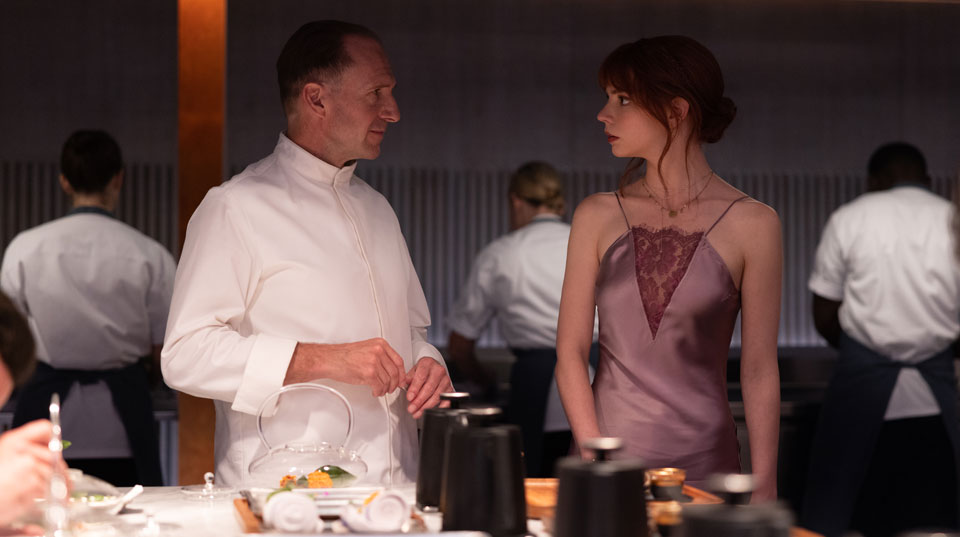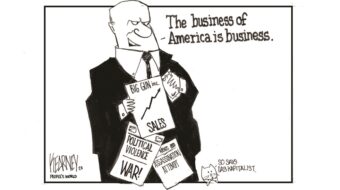
Food is a necessity to live. Every human on this planet requires nourishment to survive. But in this society—where poverty and world hunger are pressing issues—there are far too many with not enough food, and many more who go without it at all. Then there are those who have the privilege to not only afford an abundance of food, but who can also relish in the often unnecessary luxuries of decadence to be found in high-end restaurants. Food in the world of the elite goes beyond sustenance; it becomes an indication of status. The Menu is a wickedly dark comedy that uses satire to take on elitism in the world of luxury dining.
Written by Seth Reiss and Will Tracy, with Mark Mylod directing, The Menu follows a couple, Margot (Anya Taylor-Joy) and Tyler (Nicholas Hoult), as they travel to a coastal island in the Pacific Northwest to eat at an exclusive restaurant named Hawthorn. This is a spot where the reclusive and globally-celebrated Chef Julian Slowik (Ralph Fiennes) has prepared a lavish tasting menu for select special guests. The couple is joined by nine other diners, all with varying degrees of fame or wealth. As the evening unfolds, tensions rise at each of the guest tables as secrets are revealed and unexpected foods are served. Each course is more shocking than the last, as it becomes apparent that Chef Slowik’s elaborate menu is designed to spawn a shocking finale. Revelations, violence, and mayhem color the night with biting commentary baked in for good measure.
Without spoiling crucial details of the film, this is a story that deals with the pretentions of the world of high-end dining. From dainty plates priced at $50 or more, to bottles of wine that cost well into the thousands, it is a world out of reach for the average working class person aside from vicarious experiences via reality TV cooking shows. There are two types of people who typically inhabit these restaurants—the wealthy who eat the food, and the workers who prepare it. In that space, there is already an inherent class divide that, it could be argued, is a microcosm of our society. The Menu plays within this framework wonderfully, exploring all the layers and complexities that come with it.
Most of the film takes place in the small space of the restaurant, but the lack of scenery change never becomes an issue, as many of the characters add their own unique color to the atmosphere.
Viewers will spend most of their time with the diners, as bits and pieces of their personalities are revealed in the conversations at their separate tables. The three tech bros, the older wealthy couple, the renowned restaurant critic, and the famous middle-aged movie star at times play just as you’d expect stereotypes of their characters to be. The restaurant critic is pompous, the middle-aged movie star is desperate to reignite his career, the tech bros are obnoxious and arrogant. Such characterizations might seem cliché, but that appears to be exactly what The Menu is going for.
That’s because the diners aren’t just individuals, but rather representations of certain layers of society that are allowed to have money and influence over others. This works well for the plot, and fortunately, the talented members of the cast manage to turn their parts into more than talking caricatures. 
For those who work in the restaurant industry, statistics show that 60% of new establishments close within the first year, and 80% go out of business before their fifth anniversary. The last few years of the pandemic haven’t made things any easier, as dine-in restaurants were either forced to close, or workers were faced with higher exposure to the coronavirus. Even before the pandemic, many culinary employees found themselves working in an industry plagued by financial volatility and intense employer scrutiny.
That’s a lot of pressure to get the perfect soufflé.
Director Mylod seems to lean into this intensity and razor-edge focus required in most restaurants through the on-screen experiences of fictional workers. This helps add to the feeling of unease that mounts as the night goes on.
There are times when the film feels overly absurd and a bit too convenient, but that is again why high-end dining is exactly the right space for the story to unfold. In a time when people are eating pizza sprinkled with 24k-gold flakes for $2,000 just because they can afford to, luxury dining is the perfect area to reflect the absurdity of the world we live in of the haves and the have nots.
The standout performance goes to Ralph Fiennes as the mysterious Slowik. Is he a sinister figure whom the audience should hate and root against, or is he the anti-hero society has been waiting for? The Menu gives no clear answers, as all of the characters function in a gray area when it comes to their wants and actions. Fiennes shows us multiple sides of his character in subtle yet effective ways. While Anya Taylor-Joy gives a solid performance as Margot, it really is Fiennes’ movie.
Lovers of dark comedies with social bite will enjoy the film. There are many genuinely funny moments. Those who consider themselves “foodies” may either love the self-own The Menu implements, or feel attacked. Either way, it’s a wild ride with interesting twists and turns that luckily maintains its edge all the way through to the very end. Bon appétit!
Searchlight Pictures will release The Menu in theaters on Nov. 18, 2022.












Comments